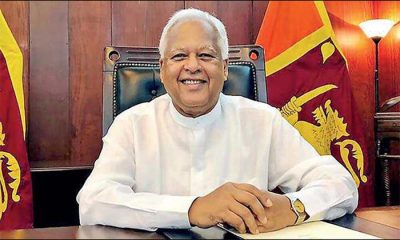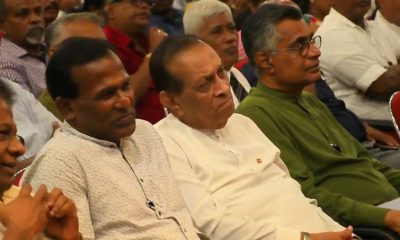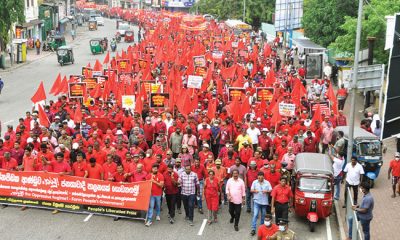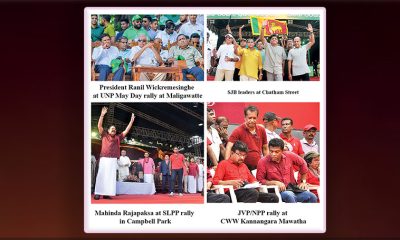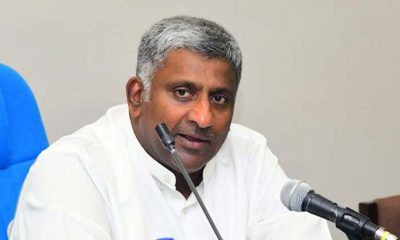Features
The presidential election and Premadasa forcing JR to go back on his promise to Mrs. B
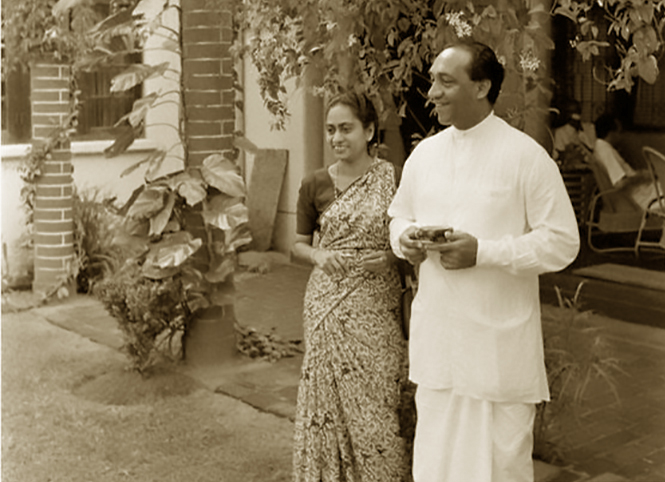
JVP murders proponents for third term; JR advised to continue by Rajiv and Lee
(Excerpted from volume ii of Sarath Amunugama autobiograph
The third Presidential election was due in 1989 and JRJ was under pressure to decide on his party candidate in good time. Premadasa was taking an early lead for the nomination supported by Ranjan Wijeratne who was, as mentioned earlier, appointed the President and Secretary of the UNP and also, as an army volunteer officer the leader in the fight back against the JVP military wing.
At this stage JRJ got a message from Rajiv Gandhi that he should contest the forthcoming election as the implementation of the Indo-Lanka accord would need his steadying hand. This was reinforced by a call from Lee Kuan Yew that JRJ should continue for another six years as President if Sri Lanka was to emerge from its crisis-ridden present. In all likelihood Lalith and Gamini who were wary of the Prime Minister would have encouraged the old man as did his coterie of intimate friends who were loath to relinquish all that power if there was a change of President.
JRJ was in two minds but he allowed a study of the constitutional implications of such a move, as his own constitution had restricted a President’s terms of office to two. Menikdiwela, a firm advocate of the third term, then collared two loyal MPs, Lionel Jayatilleke and Merril Kariyawasam, to propose that JRJ should run for a third term. He would never have done that without JRJ’s blessings. However both proposer and seconder were gunned down by the JVP within days and with Premadasa’s belligerence JRJ was forced to give up the idea, especially because his wife strongly opposed such a move and probably thereby saved his life.
Mrs. Jayewardene consistently backed Premadasa and saved him from the internal battles that have marked other political parties .Another key factor was the unstinted support given to the PM by Ranjan Wijeratne who almost single-handedly battled the JVP to the bitter end. He told JRJ that only Premadasa had a chance of giving a fight to Mrs. Bandaranaike who was to be the Opposition candidate. This was accepted by JRJ who knew that Mrs. B would loath to be defeated by Premadasa for both political and social reasons.
I was present in JRJ’s office in Braemar on November 5, 1988 when Premadasa and Ranjan barged in, in an aggressive manner and began arguing with JRJ who had just concluded a negotiation with Mrs. B to dissolve Parliament simultaneously with the calling of nominations for the Presidency. He had assured her and through her the Opposition, including the JVP, that the election would be fair. The JVP had asked for an all-party monitoring committee to oversee the election.
This decision, taken without consulting the main interested party namely Premadasa, naturally infuriated him and he and Ranjan burst into JRJ’s office and rudely criticized the President for this decision which they said undercut UNP chances of winning the election. Premadasa said that he was withdrawing his nomination and JRJ could field anyone he wanted in the forthcoming election. He wanted to contest the Presidency as the incumbent PM with a two third majority in Parliament and if that was not possible he was out of the running.
Ranjan also strongly backed Premadasa and said that the party would fare badly with any other candidate. JRJ then simply stared at the two heavyweights and made a typically bold instantaneous decision. He got Mrs. Bandaranaike on the line and told her that he was withdrawing his pledge to dissolve Parliament. “Premadasa is here in my office protesting against my decision”, he told Mrs. B, “so I have no choice but to go back on my word”.
She did not have a long response but apparently protested and cut the line. Her dismay is seen in the following paragraph of her letter sent the following day. “To my astonishment you telephoned me about one and a half hours later to inform me that after talking to the Prime Minister and some other ministers you were no longer able to fulfill the undertaking you gave me a short time before, unless the JVP agreed to serve in the interim cabinet”.
After the volte face JRJ smiled weakly at his PM and party secretary and ambled out of his office and went upstairs. But obviously that was the decisive moment when the President was outmaneuvered, and the initiative passed on to Premadasa and his well-oiled propaganda machine led by Sirisena Cooray. Notwithstanding these humiliations JRJ and his wife believed that it was only Premadasa who could deliver victory to the UNP, and they were proved right.
He got Lalith and Gamini to propose Premadasa’s name as the UNP candidate and addressed his inaugural meeting in Kandy. Tempted by Premadasa’s cynical offer of the Premiership to them both, the young aspirants .campaigned hard for him, which enabled the UNP to present a united front. Only Ronnie de Mel, who never liked the PM, changed sides and earned the wrath of Premadasa and the UNP. His role as a front ranker in the local political scene was over though later from time to time, he held several portfolios under other Presidents.
The third presidential election was held in December 1988 with Premadasa and Mrs. B as the key contestants. It was an election in which the contestants had to wade through a river of blood as the JVP used all their strength to sabotage it. It took great courage for Premadasa to carry out his election campaign amidst much difficulty. The odds were stacked against him. Mrs. B was the opponent who had the advantage of the anti-incumbency factor.
Many private sector bigwigs who normally fund the UNP crossed over to her camp especially because Ronnie de Mel was her chief fund raiser earning for himself the eternal hatred of Premadasa. All the skills that Premadasa had mastered in Colombo Central stood him in good stead. His chief of staff was Sirisena Cooray, and all decision making was devolved on him. He used the resources of the Colombo Municipality for his campaign as he was the mayor.
In spite of the naysayers, Cooray decided to hold their inaugural meeting in Kandy. He employed `Soththi Upali’ a gangster and Municipal contractor to rival the JVP in launching their poster campaign throughout the country on one night, thereby challenging the ‘mystique’ that the JVP assiduously cultivated as the ‘second government’ which could enforce its will countrywide.
The mammoth Kandy meeting was a game changer. Usually a UNP stronghold, its Kandy supporters welcomed the new populist approach of Premadasa and ignored the death threats which were by now familiar tactics of the armed wing of the JVP. In Kandy, Premadasa was helped by the support extended by the new Chief Minister of the Central Provincial Council and its members in spite of the fact that the PM had opposed the formation of Provincial Councils.
It was also a poignant moment for JRJ since it was his last major political intervention which ended a long and distinguished career. He called on the party to work hard for Premadasa whom he endorsed publicly as the winning candidate. By this time Premadasa had made it clear that JRJ would be a liability for his campaign and was not at all enthusiastic about his participation. When JRJ returned to President’s House in Kandy after the meeting, he knew that the leadership had moved to the PM, and he was to be a mere spectator. He took it with his usual inscrutability.
In addition to his courage and ambition, Premadasa planned his campaign with his usual panache. He persuaded Ossie Abeygunasekera, a Vijaya Kumaratunga loyalist, to contest the Presidency. A brilliant speaker, Ossie concentrated on attacking Mrs. B and drawing away her votes. TheJVP too attacked her which added to her lackluster performance during the election campaign. Premadasa who was eight years younger than Mrs. B, exploited the age factor which would have been a liability if JRJ had contested.
When the results were declared Premadasa had squeaked in with a much reduced poll. Ossie had also drawn a significant number of votes and added to Mrs. B’s embarrassment. When the results were announced she refused to come to the counting centre to make her concession speech thereby confirming JRJ’s prediction that she was socially uncomfortable to be challenged by an outsider like Premadasa.
In a sense this election marked the eclipse of both JRJ and Mrs. B. The former retired from the scene while the latter hung on but did not have the unquestioned authority she wielded in her halcyon years.
Soon after his victory the new President called for a parliamentary election in February which was in any case due in 1989. For the Presidential election Premadasa had wooed the minorities, especially Ashraff, who had emerged as the leader of the Eastern Province Muslims and was able to drive a hard bargain in reducing the ‘cut off point’ for eligibility for election, from the previous eight to five percent, thereby opening a Panaoras box 61 small ethnic parties which could bargain for ministerial positions, ambassadorships and state corporation jobs in exchange for their crucial support in Parliament.
These transactions or ‘deals’ became a regular feature of Sri Lankan politics and have added to the corruption which is now endemic in Sri Lankan politics.
Features
The heart-friendly health minister

by Dr Gotabhya Ranasinghe
Senior Consultant Cardiologist
National Hospital Sri Lanka
When we sought a meeting with Hon Dr. Ramesh Pathirana, Minister of Health, he graciously cleared his busy schedule to accommodate us. Renowned for his attentive listening and deep understanding, Minister Pathirana is dedicated to advancing the health sector. His openness and transparency exemplify the qualities of an exemplary politician and minister.
Dr. Palitha Mahipala, the current Health Secretary, demonstrates both commendable enthusiasm and unwavering support. This combination of attributes makes him a highly compatible colleague for the esteemed Minister of Health.
Our discussion centered on a project that has been in the works for the past 30 years, one that no other minister had managed to advance.
Minister Pathirana, however, recognized the project’s significance and its potential to revolutionize care for heart patients.
The project involves the construction of a state-of-the-art facility at the premises of the National Hospital Colombo. The project’s location within the premises of the National Hospital underscores its importance and relevance to the healthcare infrastructure of the nation.
This facility will include a cardiology building and a tertiary care center, equipped with the latest technology to handle and treat all types of heart-related conditions and surgeries.
Securing funding was a major milestone for this initiative. Minister Pathirana successfully obtained approval for a $40 billion loan from the Asian Development Bank. With the funding in place, the foundation stone is scheduled to be laid in September this year, and construction will begin in January 2025.
This project guarantees a consistent and uninterrupted supply of stents and related medications for heart patients. As a result, patients will have timely access to essential medical supplies during their treatment and recovery. By securing these critical resources, the project aims to enhance patient outcomes, minimize treatment delays, and maintain the highest standards of cardiac care.
Upon its fruition, this monumental building will serve as a beacon of hope and healing, symbolizing the unwavering dedication to improving patient outcomes and fostering a healthier society.We anticipate a future marked by significant progress and positive outcomes in Sri Lanka’s cardiovascular treatment landscape within the foreseeable timeframe.
Features
A LOVING TRIBUTE TO JESUIT FR. ALOYSIUS PIERIS ON HIS 90th BIRTHDAY

by Fr. Emmanuel Fernando, OMI
Jesuit Fr. Aloysius Pieris (affectionately called Fr. Aloy) celebrated his 90th birthday on April 9, 2024 and I, as the editor of our Oblate Journal, THE MISSIONARY OBLATE had gone to press by that time. Immediately I decided to publish an article, appreciating the untiring selfless services he continues to offer for inter-Faith dialogue, the renewal of the Catholic Church, his concern for the poor and the suffering Sri Lankan masses and to me, the present writer.
It was in 1988, when I was appointed Director of the Oblate Scholastics at Ampitiya by the then Oblate Provincial Fr. Anselm Silva, that I came to know Fr. Aloy more closely. Knowing well his expertise in matters spiritual, theological, Indological and pastoral, and with the collaborative spirit of my companion-formators, our Oblate Scholastics were sent to Tulana, the Research and Encounter Centre, Kelaniya, of which he is the Founder-Director, for ‘exposure-programmes’ on matters spiritual, biblical, theological and pastoral. Some of these dimensions according to my view and that of my companion-formators, were not available at the National Seminary, Ampitiya.
Ever since that time, our Oblate formators/ accompaniers at the Oblate Scholasticate, Ampitiya , have continued to send our Oblate Scholastics to Tulana Centre for deepening their insights and convictions regarding matters needed to serve the people in today’s context. Fr. Aloy also had tried very enthusiastically with the Oblate team headed by Frs. Oswald Firth and Clement Waidyasekara to begin a Theologate, directed by the Religious Congregations in Sri Lanka, for the contextual formation/ accompaniment of their members. It should very well be a desired goal of the Leaders / Provincials of the Religious Congregations.
Besides being a formator/accompanier at the Oblate Scholasticate, I was entrusted also with the task of editing and publishing our Oblate journal, ‘The Missionary Oblate’. To maintain the quality of the journal I continue to depend on Fr. Aloy for his thought-provoking and stimulating articles on Biblical Spirituality, Biblical Theology and Ecclesiology. I am very grateful to him for his generous assistance. Of late, his writings on renewal of the Church, initiated by Pope St. John XX111 and continued by Pope Francis through the Synodal path, published in our Oblate journal, enable our readers to focus their attention also on the needed renewal in the Catholic Church in Sri Lanka. Fr. Aloy appreciated very much the Synodal path adopted by the Jesuit Pope Francis for the renewal of the Church, rooted very much on prayerful discernment. In my Religious and presbyteral life, Fr.Aloy continues to be my spiritual animator / guide and ongoing formator / acccompanier.
Fr. Aloysius Pieris, BA Hons (Lond), LPh (SHC, India), STL (PFT, Naples), PhD (SLU/VC), ThD (Tilburg), D.Ltt (KU), has been one of the eminent Asian theologians well recognized internationally and one who has lectured and held visiting chairs in many universities both in the West and in the East. Many members of Religious Congregations from Asian countries have benefited from his lectures and guidance in the East Asian Pastoral Institute (EAPI) in Manila, Philippines. He had been a Theologian consulted by the Federation of Asian Bishops’ Conferences for many years. During his professorship at the Gregorian University in Rome, he was called to be a member of a special group of advisers on other religions consulted by Pope Paul VI.
Fr. Aloy is the author of more than 30 books and well over 500 Research Papers. Some of his books and articles have been translated and published in several countries. Among those books, one can find the following: 1) The Genesis of an Asian Theology of Liberation (An Autobiographical Excursus on the Art of Theologising in Asia, 2) An Asian Theology of Liberation, 3) Providential Timeliness of Vatican 11 (a long-overdue halt to a scandalous millennium, 4) Give Vatican 11 a chance, 5) Leadership in the Church, 6) Relishing our faith in working for justice (Themes for study and discussion), 7) A Message meant mainly, not exclusively for Jesuits (Background information necessary for helping Francis renew the Church), 8) Lent in Lanka (Reflections and Resolutions, 9) Love meets wisdom (A Christian Experience of Buddhism, 10) Fire and Water 11) God’s Reign for God’s poor, 12) Our Unhiddden Agenda (How we Jesuits work, pray and form our men). He is also the Editor of two journals, Vagdevi, Journal of Religious Reflection and Dialogue, New Series.
Fr. Aloy has a BA in Pali and Sanskrit from the University of London and a Ph.D in Buddhist Philosophy from the University of Sri Lankan, Vidyodaya Campus. On Nov. 23, 2019, he was awarded the prestigious honorary Doctorate of Literature (D.Litt) by the Chancellor of the University of Kelaniya, the Most Venerable Welamitiyawe Dharmakirthi Sri Kusala Dhamma Thera.
Fr. Aloy continues to be a promoter of Gospel values and virtues. Justice as a constitutive dimension of love and social concern for the downtrodden masses are very much noted in his life and work. He had very much appreciated the commitment of the late Fr. Joseph (Joe) Fernando, the National Director of the Social and Economic Centre (SEDEC) for the poor.
In Sri Lanka, a few religious Congregations – the Good Shepherd Sisters, the Christian Brothers, the Marist Brothers and the Oblates – have invited him to animate their members especially during their Provincial Congresses, Chapters and International Conferences. The mainline Christian Churches also have sought his advice and followed his seminars. I, for one, regret very much, that the Sri Lankan authorities of the Catholic Church –today’s Hierarchy—- have not sought Fr.
Aloy’s expertise for the renewal of the Catholic Church in Sri Lanka and thus have not benefited from the immense store of wisdom and insight that he can offer to our local Church while the Sri Lankan bishops who governed the Catholic church in the immediate aftermath of the Second Vatican Council (Edmund Fernando OMI, Anthony de Saram, Leo Nanayakkara OSB, Frank Marcus Fernando, Paul Perera,) visited him and consulted him on many matters. Among the Tamil Bishops, Bishop Rayappu Joseph was keeping close contact with him and Bishop J. Deogupillai hosted him and his team visiting him after the horrible Black July massacre of Tamils.
Features
A fairy tale, success or debacle

Sri Lanka-Singapore Free Trade Agreement
By Gomi Senadhira
senadhiragomi@gmail.com
“You might tell fairy tales, but the progress of a country cannot be achieved through such narratives. A country cannot be developed by making false promises. The country moved backward because of the electoral promises made by political parties throughout time. We have witnessed that the ultimate result of this is the country becoming bankrupt. Unfortunately, many segments of the population have not come to realize this yet.” – President Ranil Wickremesinghe, 2024 Budget speech
Any Sri Lankan would agree with the above words of President Wickremesinghe on the false promises our politicians and officials make and the fairy tales they narrate which bankrupted this country. So, to understand this, let’s look at one such fairy tale with lots of false promises; Ranil Wickremesinghe’s greatest achievement in the area of international trade and investment promotion during the Yahapalana period, Sri Lanka-Singapore Free Trade Agreement (SLSFTA).
It is appropriate and timely to do it now as Finance Minister Wickremesinghe has just presented to parliament a bill on the National Policy on Economic Transformation which includes the establishment of an Office for International Trade and the Sri Lanka Institute of Economics and International Trade.
Was SLSFTA a “Cleverly negotiated Free Trade Agreement” as stated by the (former) Minister of Development Strategies and International Trade Malik Samarawickrama during the Parliamentary Debate on the SLSFTA in July 2018, or a colossal blunder covered up with lies, false promises, and fairy tales? After SLSFTA was signed there were a number of fairy tales published on this agreement by the Ministry of Development Strategies and International, Institute of Policy Studies, and others.
However, for this article, I would like to limit my comments to the speech by Minister Samarawickrama during the Parliamentary Debate, and the two most important areas in the agreement which were covered up with lies, fairy tales, and false promises, namely: revenue loss for Sri Lanka and Investment from Singapore. On the other important area, “Waste products dumping” I do not want to comment here as I have written extensively on the issue.
1. The revenue loss
During the Parliamentary Debate in July 2018, Minister Samarawickrama stated “…. let me reiterate that this FTA with Singapore has been very cleverly negotiated by us…. The liberalisation programme under this FTA has been carefully designed to have the least impact on domestic industry and revenue collection. We have included all revenue sensitive items in the negative list of items which will not be subject to removal of tariff. Therefore, 97.8% revenue from Customs duty is protected. Our tariff liberalisation will take place over a period of 12-15 years! In fact, the revenue earned through tariffs on goods imported from Singapore last year was Rs. 35 billion.
The revenue loss for over the next 15 years due to the FTA is only Rs. 733 million– which when annualised, on average, is just Rs. 51 million. That is just 0.14% per year! So anyone who claims the Singapore FTA causes revenue loss to the Government cannot do basic arithmetic! Mr. Speaker, in conclusion, I call on my fellow members of this House – don’t mislead the public with baseless criticism that is not grounded in facts. Don’t look at petty politics and use these issues for your own political survival.”
I was surprised to read the minister’s speech because an article published in January 2018 in “The Straits Times“, based on information released by the Singaporean Negotiators stated, “…. With the FTA, tariff savings for Singapore exports are estimated to hit $10 million annually“.
As the annual tariff savings (that is the revenue loss for Sri Lanka) calculated by the Singaporean Negotiators, Singaporean $ 10 million (Sri Lankan rupees 1,200 million in 2018) was way above the rupees’ 733 million revenue loss for 15 years estimated by the Sri Lankan negotiators, it was clear to any observer that one of the parties to the agreement had not done the basic arithmetic!
Six years later, according to a report published by “The Morning” newspaper, speaking at the Committee on Public Finance (COPF) on 7th May 2024, Mr Samarawickrama’s chief trade negotiator K.J. Weerasinghehad had admitted “…. that forecasted revenue loss for the Government of Sri Lanka through the Singapore FTA is Rs. 450 million in 2023 and Rs. 1.3 billion in 2024.”
If these numbers are correct, as tariff liberalisation under the SLSFTA has just started, we will pass Rs 2 billion very soon. Then, the question is how Sri Lanka’s trade negotiators made such a colossal blunder. Didn’t they do their basic arithmetic? If they didn’t know how to do basic arithmetic they should have at least done their basic readings. For example, the headline of the article published in The Straits Times in January 2018 was “Singapore, Sri Lanka sign FTA, annual savings of $10m expected”.
Anyway, as Sri Lanka’s chief negotiator reiterated at the COPF meeting that “…. since 99% of the tariffs in Singapore have zero rates of duty, Sri Lanka has agreed on 80% tariff liberalisation over a period of 15 years while expecting Singapore investments to address the imbalance in trade,” let’s turn towards investment.
Investment from Singapore
In July 2018, speaking during the Parliamentary Debate on the FTA this is what Minister Malik Samarawickrama stated on investment from Singapore, “Already, thanks to this FTA, in just the past two-and-a-half months since the agreement came into effect we have received a proposal from Singapore for investment amounting to $ 14.8 billion in an oil refinery for export of petroleum products. In addition, we have proposals for a steel manufacturing plant for exports ($ 1 billion investment), flour milling plant ($ 50 million), sugar refinery ($ 200 million). This adds up to more than $ 16.05 billion in the pipeline on these projects alone.
And all of these projects will create thousands of more jobs for our people. In principle approval has already been granted by the BOI and the investors are awaiting the release of land the environmental approvals to commence the project.
I request the Opposition and those with vested interests to change their narrow-minded thinking and join us to develop our country. We must always look at what is best for the whole community, not just the few who may oppose. We owe it to our people to courageously take decisions that will change their lives for the better.”
According to the media report I quoted earlier, speaking at the Committee on Public Finance (COPF) Chief Negotiator Weerasinghe has admitted that Sri Lanka was not happy with overall Singapore investments that have come in the past few years in return for the trade liberalisation under the Singapore-Sri Lanka Free Trade Agreement. He has added that between 2021 and 2023 the total investment from Singapore had been around $162 million!
What happened to those projects worth $16 billion negotiated, thanks to the SLSFTA, in just the two-and-a-half months after the agreement came into effect and approved by the BOI? I do not know about the steel manufacturing plant for exports ($ 1 billion investment), flour milling plant ($ 50 million) and sugar refinery ($ 200 million).
However, story of the multibillion-dollar investment in the Petroleum Refinery unfolded in a manner that would qualify it as the best fairy tale with false promises presented by our politicians and the officials, prior to 2019 elections.
Though many Sri Lankans got to know, through the media which repeatedly highlighted a plethora of issues surrounding the project and the questionable credentials of the Singaporean investor, the construction work on the Mirrijiwela Oil Refinery along with the cement factory began on the24th of March 2019 with a bang and Minister Ranil Wickremesinghe and his ministers along with the foreign and local dignitaries laid the foundation stones.
That was few months before the 2019 Presidential elections. Inaugurating the construction work Prime Minister Ranil Wickremesinghe said the projects will create thousands of job opportunities in the area and surrounding districts.
The oil refinery, which was to be built over 200 acres of land, with the capacity to refine 200,000 barrels of crude oil per day, was to generate US$7 billion of exports and create 1,500 direct and 3,000 indirect jobs. The construction of the refinery was to be completed in 44 months. Four years later, in August 2023 the Cabinet of Ministers approved the proposal presented by President Ranil Wickremesinghe to cancel the agreement with the investors of the refinery as the project has not been implemented! Can they explain to the country how much money was wasted to produce that fairy tale?
It is obvious that the President, ministers, and officials had made huge blunders and had deliberately misled the public and the parliament on the revenue loss and potential investment from SLSFTA with fairy tales and false promises.
As the president himself said, a country cannot be developed by making false promises or with fairy tales and these false promises and fairy tales had bankrupted the country. “Unfortunately, many segments of the population have not come to realize this yet”.
(The writer, a specialist and an activist on trade and development issues . )


